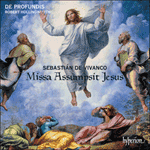Vivanco was maestro at Ávila in 1598; later he occupied the twin positions of university professor and maestro at Salamanca. We cannot determine when he wrote
Versa est in luctum. It survives in a manuscript copied long after his time and may have been among the pages now missing from the damaged copies that survive of his motet book, printed in 1610. His vocal scoring is exactly the same as that used by Lobo and Victoria for their settings of the same words. This text is one re-arranged from the Book of Job into a liturgical responsorium. Peñalosa (around 1500) had composed music for the full responsory and its verse. A century later Lobo, Victoria and Vivanco used just the responsory without the verse, clearly as a motet for para-liturgical or extra-liturgical use. During the seventeenth century, Spanish, Portuguese and New World composers set these emotive words. José de Torres published a succinct and punchy version in 1703.
from notes by Bruno Turner © 1998
Maestro à Ávila en 1598, Vivanco occupa ensuite les doubles fonctions de professeur d’université et de maestro à Salamanque. Nous ne pouvons déterminer quand il écrivit
Versa est in luctum, pièce découverte dans un manuscrit copié bien après l’époque de son compositeur et qui a pu compter parmi les pages désormais manquantes des copies endommagées de son livre de motets, imprimé en 1610. Sa distribution vocale est exactement identique à celle employée par Lobo et Victoria dans leurs mises en musique du même texte. Ce dernier, extrait du livre de Job, a été réarrangé en un responsorium liturgique. Peñalosa (vers 1500) avait composé une musique pour le répons entier et son verset. Un siècle plus tard, Lobo, Victoria et Vivanco utilisèrent manifestement le seul répons, sans le verset, comme motet para- ou extra-liturgique. Au cours du XVIIe siècle, des compositeurs espagnols, portugais et du Nouveau Monde mirent en musique ces paroles à forte teneur émotionnelle. José de Torres en publia une version, concise et incisive, en 1703.
extrait des notes rédigées par Bruno Turner © 1998
Français: Hypérion
Im Jahre 1598 war Vivanco als maestro in Ávila tätig. Später trat er in Salamanca die Doppelanstellung als Universitätsprofessor und maestro an. Doch läßt es sich nicht sagen, wann er
Versa est in luctum geschrieben hat. Es ist lediglich in Form eines Manuskripts erhalten, das lange nach seiner Zeit entstand, und gehört wohl zu den fehlenden Seiten der beschädigten Exemplare der 1610 gedruckten und bis heute erhaltenen Motettenbücher. Seine Vokalpartitur entspricht exakt jener, die Lobo und Victoria bei deren Bearbeitung selbiger Worte anwendeten. Dieser Text aus dem Buch Hiob wurde in ein liturgisches Responsorium umgearbeitet. Peñalosa (um 1500) hatte Musik zum vollen Responsorium und des dazugehörigen Versus komponiert. Hundert Jahre danach verwendeten Lobo, Victoria und Vivanco lediglich das Responsorium ohne den Versus, womit sie die Motette ganz klar zur paraliturgischen bzw. extraliturgischen Verwendung bestimmten. Während des siebzehnten Jahrhunderts bearbeiteten zahlreiche Komponisten aus Spanien, Portugal und der Neuen Welt diese gefühlsbetonten Worte. José de Torres veröffentlichte eine knappe, einprägsame Fassung im Jahre 1703.
aus dem Begleittext von Bruno Turner © 1998
Deutsch: Michael Stoffl
Vivanco era maestro de capilla en Ávila en 1598; más tarde ocupó los puestos de catedrático de universidad y maestro de capilla en Salamanca. No podemos determinar cuándo escribió
Versa est in luctum. Se conserva en un manuscrito copiado mucho después de su época y puede que se encontrara entre las páginas ahora perdidas de las copias deterioradas que se conservan de su libro de motetes, impreso en 1610. Su disposición vocal es exactamente la misma que la utilizada por Lobo y Victoria para sus obras escritas a partir de idéntico texto. Se trata de una adaptación realizada a partir del Libro de Job para convertirlo en un responsorium litúrgico. Peñalosa (en torno a 1500) había compuesto música para todo el responsorio y su verso. Un siglo más tarde, Lobo, Victoria y Vivanco utilizaron exactamente el mismo responsorio sin el verso, claramente como un motete para su uso paralitúrgico o extralitúrgico. Durante el siglo XVII, los compositores españoles, portugueses y del Nuevo Mundo pusieron música a estas emotivas palabras. José de Torres publicó una sucinta e incisiva versión en 1703.
extraído de las notas de Bruno Turner © 1998
Español: Luis Gago


 The Golden Age
The Golden Age Vivanco: Missa Assumpsit Jesus & motets
Vivanco: Missa Assumpsit Jesus & motets
